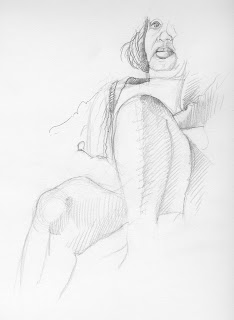Throughout my artistic life I've always wanted my work whether drawing, painting or any other medium, to be interesting at a distance AND up close! I want to pull the viewer in, get him involved in the "subject" and in the "work". Illustrating that idea and expanding on the concept of the "mark" I wrote of in a previous entry, here are three pencil drawings: (1) A relatively simple drawing of a pear with strong side-light, (2) an unfinished figure drawing and (3) a much more finished (old) self-portrait.
Tho' the medium in these three are all pencil, producing softer marks than the ink drawings of previous posts, you're still aware of the "mark". You see the varying pressures the artist uses as he strengthens and lightens his lines. You see the repetitive strokes of his pencil in hatching and cross-hatching, creating an illusion of light and shade, and thereby "form". Aside from giving the drawing a nice textural interest, those hatchings do one more thing. Looking closely you can almost relive the artist's experience, following his hand as he draws and so understand that as he converts his observations of a three dimensional object into marks on a flat surface, he creates an object. Not just a "picture" of something but a collection of marks that add up to an interesting object, a "work of art".



Phil, this is the kind of work of yours that I feel I know and like best, perhaps because you were doing much of it during the time I had you as a teacher. I especially love the pears. The pears you did in color are wonderful, too. They please both up close and from a distance. --Susan
ReplyDeleteLove your and your sensibilities.
ReplyDelete'I want to pull the viewer in, get him involved in the "subject" and in the "work".'
IMO An interesting drawing has tension in it. There should be something unresolved or unsettled that causes the experience to shift around in the viewers mind. An unfinished drawing can accomplish this because the viewer has to finish the drawing himself in his own mind and call on his own internal imagery to do so.